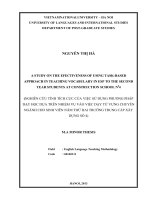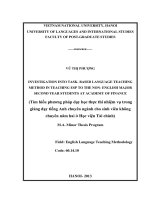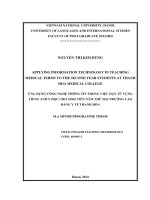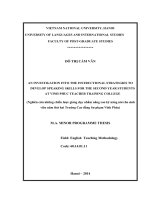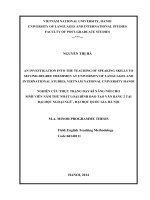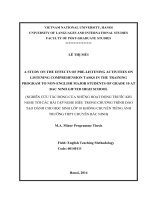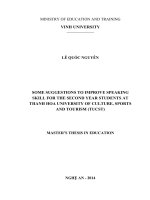Incooporating team work activities into listening lessons to motivation the non-english major second year students at university of science of science (HUS)
Bạn đang xem bản rút gọn của tài liệu. Xem và tải ngay bản đầy đủ của tài liệu tại đây (231.71 KB, 7 trang )
Incooporating team work activities into listening
lessons to motivation the non-english major
second year students at university of science of
science (HUS)
Đặng Thị Thu Thủy
Trường Đại học Ngoại ngữ
Luận văn ThS. Chuyên ngành: English teaching methodology; Mã số: 60 14 10
Người hướng dẫn: Nguyen Thi Ngoc Quynh, Ph.D.
Năm bảo vệ: 2013
Keywords: Kĩ năng nghe hiểu; Giao tiếp; Tiếng Anh; Phương pháp giảng dạy
Content
PART 1: INTRODUCTION
This chapter focuses on six main parts namely the rationale for the study, the objectives;
the scope of the study; the significance of the study; the method used to conduct this research
and the organization of the study.
1. Rationale of the study
Since English has become one of the most influential languages in the world, it has been
widely taught at many universities for such a long time. English is considered to be a means of
communication which people use to exchange information, share experience as well as to
broaden their mind. Nevertheless; the goal of acquiring it for communication has not been
emphasized. In addition, although there has been much innovation in English Teaching
Methodology, students have some difficulties in listening comprehension in the target language
(Huyen, Ng (2010:14).
With the aim of motivating students into listening classes and involving them into
cooperative practice, the teachers improved their teaching methods by applying CL into their
classes; incorporating cooperative teamwork activities in listening classes. However, the current
situation of incorporating cooperative team work activities to motivate the second year - students
has not been examined. Therefore; this study focuses on investigating the current situation of
using these activities in listening class and students’ attitude towards them to find out some
practical methods so as to incorporate them into listening class to motivate the second year
students in HUS.
2. Objectives of the study
The study aims at:
Investigating the current situation of using cooperative teamwork activities used
in listening class for non – English major second year students in HUS
Exploring the students’ preferences for these activities
Identifying students’ attitudes and teachers’ ones towards cooperative teamwork
activities in their listening lessons.
Suggesting some recommendations/ methods for incorporating/ implementing
cooperative teamwork activities in the listening lesson to motivate non – English
major second year students in HUS
In order to achieve these objectives, three research questions were raised:
Which cooperative team work activities are currently used in listening lessons
for non – English major second year students at HUS?
What is the situation of using these activities in listening lessons in HUS?
Which cooperative team work activities are the students’ preferences?
3. Significance of the study
The study is conducted to examine the current situation of using cooperative teamwork
activities and students’ attitude towards them in order to indentify some practical methods to
motivate non – English major second year students at HUS. Therefore; it is expected to bring
about some advantages to both the lectures and students at HUS. The first and foremost aim;
thus, is for the sake of the students. The researcher hopes that the students will raise their
awareness of the benefits of teamwork activities in their listening lessons; hence, they will
cooperate with their partners to achieve their common goals. Besides, it is hoped that the study
will help teachers absorb, adjust their teaching methods as well as design teamwork activities
appropriately in their own teaching lessons. Furthermore, this study is also believed as a reliable
source of reference for all lecturers, teachers or those who are concerned.
4. Scope of the study
There is a variety of means and factors which play important roles in the teaching of
listening skills. Considering the objectives and research questions, the study concentrates on the
effectiveness of cooperative teamwork activities used in listening lesson at HUS, not in other
linguistic lessons, which interferes with students’ ability to determine the level of listening
comprehension or motivate students in listening lessons. More specifically, the researcher
focuses on cooperative teamwork activities used in listening class for non – English major
second year students at HUS find out some students’ preferences and effective methods to
motivate students in listening lessons.
In terms of participants, the study investigates 84 non – English major second year
students at HUS. In addition, 5 lecturers of English teaching in these classes will be included in
this research.
5. Method of the study
The research is conducted basing on both qualitative and quantitative methods.
First, quantitative methods were applied to investigate the participants’ performance in
listening lessons. Quantitative analysis was involved in the process of data collection and
analysis via some pieces of information collected by class observation. The checklists were
carefully noted down to provide some proofs happening in listening classes.
Additionally, questionnaires which aimed at investigating students’ attitudes towards
cooperative teamwork activities; listening lessons and their preferences for cooperative
teamwork activities which influenced on their participation in listening lessons were utilized.
Close-ended; open-ended questionnaire items and rating scale response were used. The survey
was carried out with the participation of 85 non – English major second year students at HUS
who come from some different Departments. They were asked to complete the questionnaires.
Besides, qualitative approach was also involved in the process of data collection, the
ideas in semi – unstructured interviews with 5 lectures at HUS contributed much to the data
analysis. After that, the researcher processed the data and drawn conclusions basing on these
instruments.
6. Organization of the study
This minor thesis consisted of three main parts namely Introduction, Development and
Conclusion.
Part one: Introduction briefly introduced the general background information of the study
such as the rationale and statement of the problem; objective of the study research questions;
significance of the study; scope of the study, method of the study and design of the study
Part two: Development was divided into 3 small chapters as follows:
Chapter 1: Literature reviews discussed the theoretical background knowledge that is
relevant to the study
Chapter 2: Research Methodology provided some pieces of background information
related to the participants such as the context, etc… and the methods of collecting data
Chapter 3: Discussion and Findings provided the detailed results of the surveys and
covers an analysis of a range of data and interprets the findings of the research
Part 3: Conclusion: This part included a review of the study, recommendations;
limitations of the study and suggestions for further researches.
REFERENCES
I/ Foreign Researchers
1. Adams, D.N. & Hamm, M.E. (1990) Cooperative learning - Critical thinking and
Collaboration across the curriculum, Springfield, IL: Charles C Thomas.
2. Anderson, A., & Lynch, T. (1988). Listening. New York: Oxford University Press.
3. Brant, R. (1987). On cooperation in schools: a conversation with David and Roger
Johnson. Educational Leadership, 45 (3), 14- 19.
4. Brown, G., & Yule, G. (1983). Teaching the spoken language. Cambridge: Cambridge
University Press.
5. Cohen, E. G. (1991). Finding out/Descrubrimiento: Complex Instruction in Science:
Cooperative Learning, 1, 30 – 31.
6. Daniels, S. E., & Walker, G. B. (2001). Working through environmental conflict: The
Collaborative learning approach. Westport, CT: Praeger
7. David, B. (1993). Tools for Teaching. San Francisco: Jossey – Bass.
8. Dirkx, J.M. (1998). Approaches to active learning in adult education: Tips, strategies,
and techniques for teaching adults. Washington, D. C.: American Association of Adult and
Continuing Education.
9. Field, J. (2000). Finding one’s way in the fog: Listening strategies and second language
learners. Modern English Teacher, 9(1), 29-34.
10. Godwin, M.W. (2003). Cooperative Learning and Social Skills – What skills to teach and
How to teach them. Retrieved June, 20
th
, 2013 from
11. Hamm, M. & Adams, D. (1992). The Collaborative Dimensions of Learning. Norwood,
NJ: Ablex Publishing.
12. Jacobs, G. M., Lee, C, & Ng, M. (1997). Co-operative learning in the thinking classroom
13. Johnson, D.W. & Johnson, R.T. (1989) Cooperation and competition: Theory and
research, Edina, MN: Interaction Book Company.
14. Johnson, D.W. & Johnson, R.T. (1990). Cooperative learning and achievement. In S.
Sharan (ed.), Cooperative learning: Theory and research, 23-37. New York
15. Johnson, D.W., & et al. (1990). Circles of learning. Cooperation in the classroom (3
rd
ed.).
New York.
16. Kagan, S. (1994). Cooperative learning. San Clemente CA: Kagan Cooperative Learning
17. Kagan, S. (1995). Cooperative learning structures for class building. San Clemente CA:
Kagan Cooperative Learning
18. Myers, J. (1991). Cooperative learning in heterogeneous classes. Cooperative Learning.
11(4).
19. NSW Institute of Teachers. Professional Teaching Standards. Retrieved on June, 20,
2013 from
20. Orr, J. (May, 2010). Collaborative activities for the secondary English classroom.
Retrieved on May, 19, 2013 from www.tealservices.net
21. Palmer, G., Perter, R., & Streetman, R.(2008). Cooperative Learning: From Emerging
Perspectives on Learning, Teaching and Technology. Retrieved on June, 15
th
, 2013, from
/>rative_Learning
22. Panitz,T.(1999). Benefits of Cooperative Learning in Relation to Student Motivation. In
M. Theall (Ed.), Motivation from within: Approach for encouraging faculty and students to
excel, New Directions for Teaching and Learning. San Francisco.
23. Richard, J.C., Platt, J., & Platt, H. (1997).Longman Dictionary of Language Teaching
and Applied Linguistics: Longman.
24. Smith, B.L and MacGregor, J. T (1992). What Is Collaborative Learning? Washington
Center, Pennsylvania State University. Retrieved on June, 20
th
, 2013 from
25. Smit, D.W.(?) Some Difficulties with Collaborative Learning. Composition Theory for
the Postmodern Classroom. State University of New York Press.
26. Valentino,C.(2000).Flexible Grouping. Retrieved May, 19
th
, 2013 from
ence/profdev/articles/valentino.html
27. Winter (1999). Cooperative Learning: Students Working in Small Groups. Speaking of
Teaching. Stanford University. 10(2).
28. (?), (2006). Students Learning Groups. Suggestions and reflections on Teaching and
Learning. Center for Excellent Presents. Retrieved on June, 20
th
, 2013 from:
II/ Vietnamese researchers
29. Canh, L.V.(2003). Understanding Foreign Language Teaching Methodology. Vietnam
National University, Hanoi Publishing House, Hanoi.
30. Ha, Ng.T.M(2010). Enhancing the third year non major students’ participant in speaking
lesson through collaborative activities at Hanoi University of business and technology. Minor
Program Thesis.Vietnam National University, Hanoi.
31. Huong, T.T.T(2006). Increasing the Effectiveness of Group Work in English Speaking
Lessons at Hoang Van Thu Gifted Upper Secondary School, Hoa Binh. Unpublished Minor
Program Thesis Linguistics, Vietnam National University, Hanoi.
32. Huyen, Ng.D(2010). A study on the effects of pre-listening activities on the listening
performance of non-major 10th grade students at Nguyen Gia Thieu High school, Hanoi. Minor
Program Thesis, Vietnam National University, Hanoi.
33. Phuc, Ng.T (2010). Teamwork activities in the 11th form speaking lessons at Lomonosov
Private High School. Vietnam National University, Hanoi.
34. Thanh,Q.T.T(2010).Using cooperative learning principles in structuring groups to
enhance participants in speaking lessons of second year college students of English. Minor
Program Thesis, Vietnam National University, Hanoi
35. Thuy, T.H (2010). Using group wok to improve speaking skill of the first – year students
at the College of Technology and Economics in trade. Minor Program Thesis, Vietnam National
University, Hanoi.

